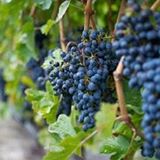We took the most amazing trip to France for our friend Julia and Peter's wedding. It was our first time in Europe and we stopped in Italy, too (a post on Italian wines to come soon)!
We stayed one more day after the wedding and did some exploring in Montpellier, France which (surprise!) took us to an amazing little wine bar in the heart of the city, L'Atelier de la Canourgue. They were so nice and conversational, asking us about wine bars in the U.S. (they thought it was funny that a place we frequent is called "Grand Cru") and were happy to give us their recommendations... and we are so happy we asked.
This is the first of three incredible wines, we had there.
Champagne Feneuil-Coppee Brut Tradition, Premier Cru
€18
This is, to date, one of the best, if not the best, Champagnes I have ever had. It's made mainly with Pinot Noir and Pinot Meunier, two of the "big three" grapes used in Champagne; the other is Chardonnay. It comes from a small producer located in Chamery, a brother and a sister, fourth generation vinegrowers. It is slightly fruity on the nose, full and flavoral on the palette with notes of toast and almond with a crisp finish.
This wine is known as a grower champagne, which can be identified by a marking on the label, R.M., Récoltant-Manipulant, or R.C., Récoltant-Coopérateur. This type of Champagne is considered more artisanal and the grapes are typically sourced from a single vineyard. Larger Champagne houses can source their grapes from many vineyards all over the region.
This Brut Tradition is an R.C., and the grapes are sourced from their vineyard and made into wine entirely by a cooperative winemaking facility.
I learned to look for this on the label when it was pointed out to me by one of the co-owners of Arrowine, who was nice enough to help me figure out if I could get this wine in the U.S. (after I returned).
Fun Fact: The Champagne region has a rich history that is
incredibly fascinating, but for the sake of brevity, I will share just one
fun fact this time.
The term "Brut" comes from the French word for raw and refers to the sugar level added to the wine, called "dosage." Brut is very dry, but not as dry as Extra Brut, or Brut Nature. The widow, or Veuve, Clicquot, who took over her husband's wine business after he passed away, was the first to adjust sugar levels in champagne.
Unfortunately, after several attempts at locating this wine for purchase in the U.S., I was not having any luck so I reached out to the winery, who said they do not sell here because they are such a small producer. Who knows, maybe someday that will change! If you are ever in France or Europe, I would definitely seek this one out, it is truly special.
And for all of the super wine nerds out there like myself: if you would like to learn more about Champagne, there is a free game app I would recommend called Champagne Campus.
Part two and three, on a red, and a white wine, to come soon. Cheers!



